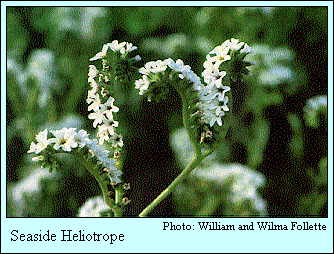Sylmar Pioneer Cemetery as a Natural History Study of "A Geography of Hope"
Via a Website
by
Robert Jan 'Roy' van de Hoek
Biologist - Geographer - Environmental Historian - Naturalist - Archaeologist
July, 2005

The original pristine prairies of the vast plains (llanos in Spanish) in the San Fernando Valley and Los Angeles have all but been eliminated. Today, in 2005, we can only find small remnants, or fragments of this once vibrant and widespread ecosystem in southern California. Cemeteries, roadsides, parks, baseball fields, airport runways, and vacant lots are the only places in Los Angeles where they persist at this time. The tell-tale signs of a prairie are the presence of soil diggings by ground squirrels and gophers, or a hawk flying overhead in a circular glide and swooping down on its prey, such as a squirrel or gopher. Another good way is to look for certain wildflowers that are persisting in these remnant fragments as defacto relicts in an otherwise urban jungle of asphalt, trees, lawns, and buildings. These wildflowers are an indicator, just as the squirrel and gopher, of a former prairie meadow.
The remnant prairie meadow at the Pioneer Cemetery in the Los Angeles suburb of Sylmar is such a place with indicator wildflowers, gophers, and squirrels. The Sylmar Cemetery is historic and a very special place. The discovery that butterflies and birds also visit the prairie meadow at the Sylmar Cemetery was a pleasant surprise too. Here is an example of a web page to select for a photograph of a Skipper Butterfly which is common to prairie meadows near the coast of Los Angeles in Playa del Rey.
Each summer, from June to September, the historical Sylmar Pioneer Cemetery is carpeted with an important indicator wildflower of a prairie meadow, which is a native plant called by the Mexicans in their Spanish language as Yerba del Pescado. Later, after California statehood, new American immigrant pioneers from the midwest and eastern United States attached various folk names to this native wildflower, such as Sheep Weed, Stick Weed, Flannel Weed and Turkey Mullein, according to Willis Jepson (1936, Flora of California, volume 2, page 417). The application of "weed" to the name is false, as it is an important native plant in ecology as the seeds of this plant are sought after by birds. The plant was used as a medicine and for food procurement of fish by California Indians and Spanish-Mexican pioneers, so it is not truly a weed. As the 20th Century began, the Mexican name and three of the American pioneer names for this wildlfower passed into disuse, with only Turkey Mullein surviving into the 21st Century as the common vernacular name for this ecologically significant native plant. Some people call it Dove Plant as the beautiful Mourning Dove is fond of the seeds. Scientists call this plant Eremocarpus setigerus. In 1936, Willis Jepson, foremost botanist and professor at the University of California, wrote a geographical note about this wildflower, which is now a historic statement as it was written 70 years ago. I will conclude this preliminary essay about the prairie meadows of Los Angeles and the Sylmar Pioneer Cemetery with an excerpt of Willis Jepson's "geographic note" that he wrote so long ago now, for this spectacular wildflower that California Indians, Spanish, and Mexican citizens called "Yerba del Pescado, " as follows:
"Geog. note. - Throughout cismontane California at low altitudes Eremocarpus setigerus is one of the most common and widely distributed plants of the dry open plains and foothills during the rainless season. On the undulating plain on the east side of the Great Valley, between the alluvial floor and the first foothills, it is more common, during the dry period, than any other species. For hundreds of miles these tiny plants, 1/2 to 1 or 2 inches high, forming a rosette of leaves on teh round with a small central cluster of flowers, dot the rolling gravelly plain and often, in July, represent over extensive areas almost the only living vegetation. Or again in looser or richer soil the plants enlarge in size to low mounds a few inches high or 1/2 to 1 1/2 feet across. Wherever there is summer fallow cultivation of the soil the Turkey Mullein becomes an impressive plant, flourishes extremely and adapts itself well to broken ground. Undoubtedly its natural range has been much extended by sheep, whence the folk name of Sheep Weed... The California Indians used the heavy-scented herbage of this plant to stupefy fish in small streams in order that they might be caught by hand, whence the Spanish-Californian name, Yerba del Pescado. The seeds form an important resource for foraging turkeys and are also eaten by Mourning-Doves. The Turkey Mullein is also known to the folk as Stickweed and Flannel Weed."
MORE LOS ANGELES PRAIRIE WEBSITES
Playa del Rey Praire and Sand Dune
